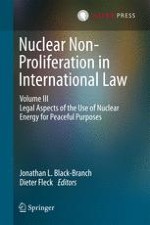2016 | OriginalPaper | Buchkapitel
6. Peaceful Uses of Nuclear Energy Under EURATOM Law
verfasst von : Jürgen Grunwald
Erschienen in: Nuclear Non-Proliferation in International Law - Volume III
Verlag: T.M.C. Asser Press
Aktivieren Sie unsere intelligente Suche, um passende Fachinhalte oder Patente zu finden.
Wählen Sie Textabschnitte aus um mit Künstlicher Intelligenz passenden Patente zu finden. powered by
Markieren Sie Textabschnitte, um KI-gestützt weitere passende Inhalte zu finden. powered by
